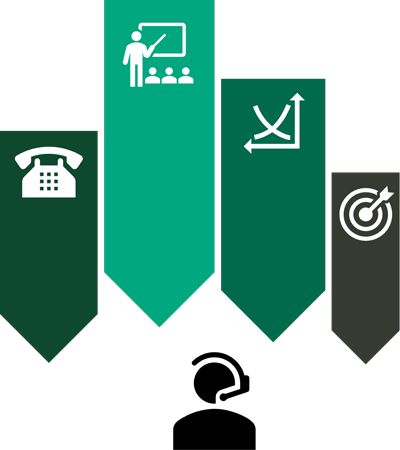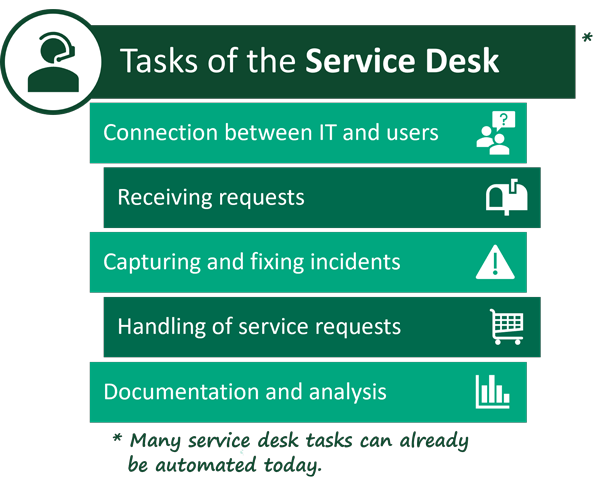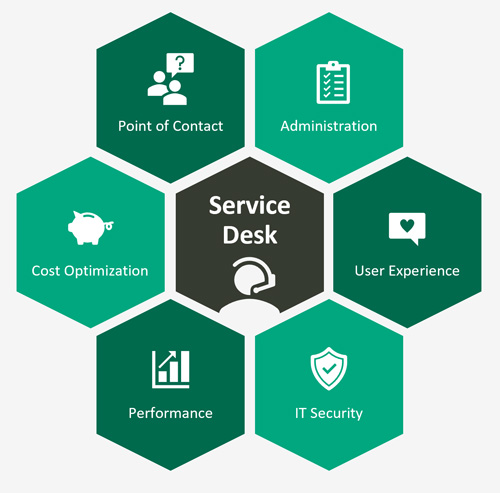The Service Desk is a fundamental tool for Information Technology Service Management, or ITSM for short. The ITIL framework defines the service desk as “the communication interface between the service provider, the employees of various departments and all users” and as “the key point of contact between the service provider and the users”. The term Single Point of Contact, or SPOC for short, is often used in connection with the Service Desk.
ITIL differentiates the structures of the Service Desk into local, central, virtual or “follow the sun”:
- Local: A local Service Desk is characterized by its physical proximity to the users to be supported. Place, region or country are identical with those of the users.
- Central: It can be more cost-effective than maintaining a large number of local Service Desks to consolidate a company’s tasks, employees and services in one place. In this case, one speaks of a central Service Desk.
- Virtual: In a virtual Service Desk, there is a single point of contact, but employees work distributed across different offices, locations or even countries. Thanks to modern communication tools and an Internet connection, Service Desk tasks can be performed regardless of location. If the underlying business or service processes are correctly summarized and designed, the impression of a central processing instance is conveyed. This promotes clarity and simplifies use for the user.
- Follow the Sun: Global organizations use Service Desks spread across multiple time zones for 24/7 support. If the sun sets in Europe, the message is sent to the USA for processing, for example. If it becomes evening there, the message moves on to Asia. Message processing thus follows the sun around the globe.
So much for the Service Desk definition. As a subset of ITSM, the Service Desk does the following:
In short, an IT Service Desk is the interface between service recipient and service provider and connects customers and IT and service teams as part of IT service management.
What functions does a Service Desk offer?
The Service Desk covers a wide range of functions and is intended to act as the main point of contact for all IT requirements. Thus, the Service Desk plays a central role in the technology ecosystem and in the IT Service Management infrastructure.
The primary goal of the Service Desk is to provide a high-quality and defined IT service for internal and external customers (e.g. as part of so-called Service Level Agreements). The Service Desk is therefore customer-centric and comprises various processes that are geared towards the needs of customers. A distinction is made between technical and organizational framework conditions.
Examples of organizational frameworks include:
- the Service Request Fulfillment (processing of service requests)
- the classification and analysis of incidents (service disruptions)
- Optimal support in day-to-day business
- the continuous improvement of all IT services
To ensure this, certain technical functionalities in a Service Desk software solution are of particular importance:
- Modules for Event, Problem, Release and Knowledge Management
- Workflow components to design simple workflows and processes
- Comprehensive reporting for problem analysis and service process improvement
In addition, certain framework factors are important as a complement to efficient service processes:
- Proactive advice and derivation of appropriate measures
- Focus on long-term strategy
- Holistic view of the customer organization and current developments
- supplementary 2nd and 3rd level support
Of course, features such as knowledge management and reporting are very important in a Service Desk solution, but the Service Desk should also be easy to use and set up, enable collaboration and be customizable to your requirements. In this way, an IT team can quickly provide excellent support and create added value for the company.
In most organizations, however, the Service Desk is not limited to IT-related services. Other business processes can also be integrated, for example:
- Travel booking
- Induction of new employees
- Infrastructure Management
- Onboarding of new providers and their management
- Data and reporting
- Documentation Management
For which tasks is a Service Desk helpful?
A typical Service Desk manages events and service requests. It also takes care of communication with users. Specifically, an IT Service Desk is used for the following tasks:
The tasks of a Service Desk team therefore include both the fast and goal-oriented receipt of service requests and the qualification of requests, which can include faults, problems, tickets and incidents. This primarily involves support for routine tasks, which are managed via tickets and incidents, and other services, such as Change and Release Management or configuration tasks.
In practice, incoming service requests are classified and qualified by assigning them to subject areas (dispatching) – in the best case, automatically – and by assigning them to the appropriate service employees. In the following, they take care of solving the requests. Tickets are automatically assigned based on predefined processes and the allocation of skills to employees and departments. This shortens the processing time and improves the solution quality.
What are the advantages of a Service Desk?
A well-structured and efficient IT organization is the linchpin of successful business for companies today. A well-managed Service Desk can help by taking over much of the routine IT work. This is because IT is relieved and can concentrate on tasks that are of greater value to the company.
As a result, an IT Service Desk offers any organization a cost-effective way to take simple work away from expensive engineering teams and subject matter experts, resulting in the best possible scalability and, subsequently, cost savings.
As the starting point for many important processes and services, the Service Desk is an interface between IT, users and business processes. Assuming data evaluation, this feature can be used to gain deep insights into user satisfaction and attitudes toward services and offerings.
Due to the large number of requests handled by the Service Desk, every company can therefore also use the IT Service Desk as an analysis tool and subsequently promote or maintain user satisfaction. A Service Desk can thus make an important contribution to a successful value chain.
But it is not only retrospectively in terms of analysis options that a Service Desk offers added value for companies; it is also possible to use the tool proactively. The early warning system provided by the Service Desk can enable proactive Problem Management, preventive maintenance, and modifications to mitigate the impact of outages for users.
Summary of the main advantages
Help Desk vs. Service Desk: What are the differences?
Companies often choose the name for their IT support arbitrarily and therefore Service Desk and Help Desk can also mean the same thing to some extent. It can also be assumed that a Help Desk offers a subset of the services of a Service Desk and that its scope of services is limited in contrast to the Service Desk. Formulations such as the further development of the Help Desk into a Service Desk fit in with this. However, if you take a closer look, the two tools differ as follows:
- The Service Desk is a further development of the Help Desk based on the ITIL framework and the concept of managing IT as a service.
- The Help Desk has developed from the IT orientation (mainframe computing), while the Service Desk has developed from the IT service orientation (based on the ITIL-supported approach to providing IT as a service).
- Depending on the company, you can also say that a Help Desk is more tactically oriented, while a Service Desk is more strategically oriented.
- With a Service Desk, the focus is on providing users with services (requests of all kinds) that go in the direction of customer service. A Help Desk, on the other hand, is designed for problem resolution alone (Incident Management).
- Unlike the Help Desk, the Service Desk is part of an IT service delivery system of an IT support ecosystem based on the so-called service lifecycle. This is also the key reason for using the term Service Desk instead of Help Desk in the ITIL framework.
Service Desk and integration into existing communication channels
If a Service Desk offers so many advantages, the question arises as to why employees are so reluctant to create tickets and still prefer to pick up the phone or contact IT directly. Reasons for this may be as follows:
As a result, many employees think it’s way too complicated to create a ticket. Therefore, they save going through the Service Desk and call someone from the IT team directly. Such scenarios happen not infrequently. But there are intelligent solutions for this, such as integrating the Service Desk into Microsoft Teams and using chatbots.
Intelligent ITSM systems also automatically submit tickets with all relevant technical information (e.g. asset management and CMDB) so that the Service Desk employee has fewer or no queries to make.
And this is exactly what REALTECH makes possible – without the detour via the actual Ticket System. The integration can also be easily used via mobile devices, allowing easy access in the event of a PC failure or while on the move. This also reduces the inhibition threshold for your employees to actually use the Service Desk, and statements such as that the Ticket System is too complicated or that a direct and personal exchange with IT works better are a thing of the past.
Find out more about simple ticketing in Microsoft Teams.
A Service Desk is an essential part of IT operations and is relevant for companies of all sizes. This is because it plays a key role in securing requests and lays the foundation for IT services to meet business objectives. Thanks to intelligent integration into existing communication channels such as Microsoft Teams, every company can benefit from the comprehensive advantages of an IT Service Desk.





